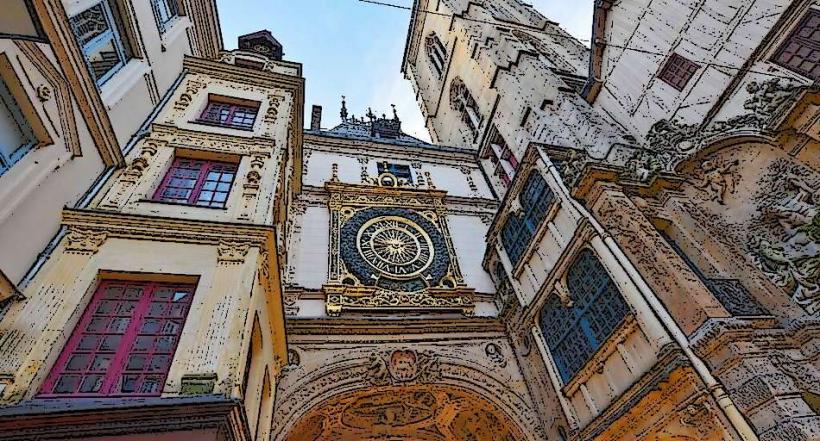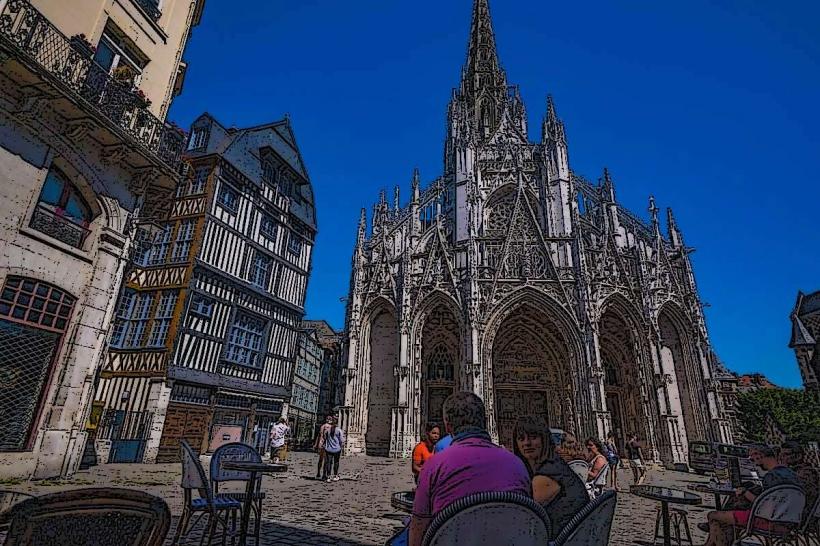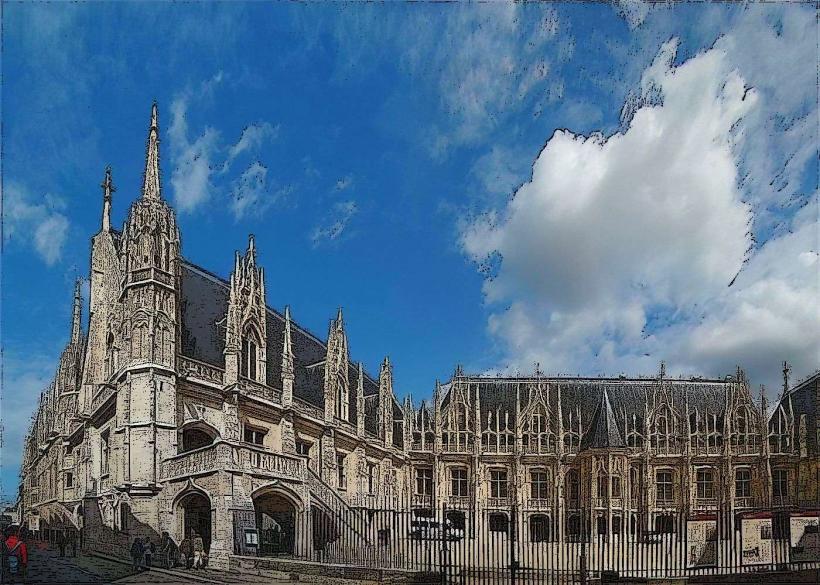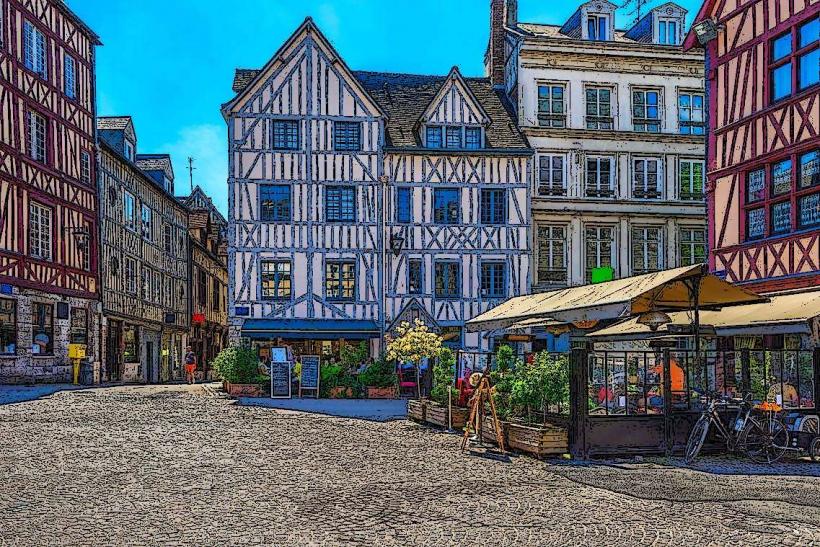Information
Landmark: Rouen CathedralCity: Rouen
Country: France
Continent: Europe
Rouen Cathedral (Cathédrale Notre-Dame de Rouen) is one of the most iconic landmarks in Rouen, the capital of the Normandy region in northern France. The cathedral is a stunning example of Gothic architecture and is known for its towering spires, intricate facades, and its historical significance. It is dedicated to Our Lady of Rouen (Notre-Dame de Rouen) and has been a central feature of the city's skyline for centuries.
History and Construction
Early Origins: The history of Rouen Cathedral dates back to the 4th century, though the current structure primarily dates from the 12th to 16th centuries. The cathedral has undergone several phases of construction, destruction, and rebuilding throughout its long history. Its role as a religious center in Rouen dates back to the early medieval period.
Gothic Style: The cathedral's current Gothic design, with its pointed arches, ribbed vaults, and flying buttresses, was established in the 13th century. The construction was initially initiated around 1030, but it wasn't until the early 1200s that work on the Gothic structure truly began. It was eventually completed over several generations, with additions continuing through the Renaissance period.
Fire Damage and Rebuilding: The cathedral was heavily damaged by fire in 1200, which led to significant rebuilding efforts. However, it also survived numerous other disasters, including the Hundred Years' War and damage during World War II. Much of the cathedral, including its spires, was repaired after these events.
Key Features of Rouen Cathedral
Facade
Sculptural Decorations: The cathedral’s facade is one of its most prominent features, with rich sculptural details depicting scenes from the Bible and saints. The intricate carvings make it a masterpiece of Gothic architecture.
Three Portals: The facade of the cathedral is divided into three main doors, each with beautiful sculptures. The central portal is dedicated to the Last Judgment, while the side portals are adorned with figures of Saints and Christ.
Rose Window: The cathedral's famous rose window is a remarkable example of medieval stained glass. The window depicts a large circular design, showing scenes from the life of Christ.
Spire
Tallest in France: Rouen Cathedral is home to one of the tallest spires in France, reaching a height of 151 meters (495 feet). It was the tallest building in the world from 1876 to 1880, before being surpassed by the Strasbourg Cathedral. The spire is a symbol of the cathedral's grandeur and dominance in the city's skyline.
Gothic Architecture: The cathedral's spire is designed in the Flamboyant Gothic style, characterized by elaborate traceries and pointed arches. The spire was added to the cathedral in the 16th century and is a stunning visual focal point.
Interior
Nave and Choir: Inside, the cathedral features an immense nave supported by slender, towering columns that rise to the vaulted ceiling. The choir is also striking, with beautiful stained glass windows and a wooden altar. Visitors are often struck by the cathedral’s vast size and the ethereal quality of light streaming through the windows.
Stained Glass: The cathedral’s stained glass windows are famous for their exceptional craftsmanship. The windows depict biblical scenes, saints, and other religious figures, creating an almost otherworldly atmosphere inside.
Chapels: The interior contains several chapels, each with its own set of paintings and sculptures. Some of the chapels are dedicated to specific saints, while others commemorate historical events or families.
Joan of Arc Connection
Joan of Arc’s Trial: Rouen Cathedral is historically significant due to its connection to Joan of Arc, the national heroine of France. Joan of Arc was tried and condemned in Rouen in 1431, and her trial took place in the Archbishop's Palace, which was located near the cathedral. She was later executed by burning at the stake in the city’s Old Market Square, just a short distance from the cathedral.
Memorials: A memorial to Joan of Arc is located near the cathedral, and a stained glass window in the cathedral is dedicated to her memory.
Famous Artistic Depictions
Claude Monet's Paintings: Rouen Cathedral is also famous for its portrayal in the works of the artist Claude Monet. Monet painted several versions of the cathedral, focusing on the interplay of light and shadow on the facade, which he captured in different weather conditions and times of day. These paintings are part of Monet's renowned Impressionist series, which explores how light affects the appearance of objects over time.
Impressionist Masterpieces: Monet’s famous series of paintings of Rouen Cathedral exemplifies the Impressionist style, where the effect of light and the passage of time are more important than precise detail. These works are now housed in major museums worldwide, including the Musée d'Orsay in Paris.
Significance and Recognition
Religious Importance: As the seat of the Archbishop of Rouen, the cathedral has been an important center of Christianity in northern France for nearly a millennium. It remains an active place of worship and is visited by thousands of pilgrims each year.
Cultural Heritage: The cathedral is a UNESCO World Heritage Site as part of the Normandy region’s cultural heritage. It is considered one of the finest examples of Gothic architecture in France.
Tourism: Rouen Cathedral attracts both religious pilgrims and secular tourists alike, drawn by its architectural beauty, artistic history, and connection to significant historical events.
Visiting Rouen Cathedral
Location: Rouen Cathedral is situated in the heart of Rouen, just steps away from the city’s vibrant medieval streets. It is one of the main attractions in the historic center of the city.
Opening Hours: The cathedral is typically open to visitors every day, though it’s always recommended to check the official website for current hours and any religious services or special events.
Admission: Entrance to the cathedral is free, but some areas, such as the tower or crypt, may require an entrance fee.
Conclusion
Rouen Cathedral is a breathtaking example of Gothic architecture, with its towering spires, intricate facades, and stunning interior. Its historical significance, particularly its association with Joan of Arc, adds layers of cultural importance to the structure. Whether you are an art enthusiast, history lover, or simply someone who appreciates magnificent architecture, Rouen Cathedral is a must-see landmark when visiting Rouen.





